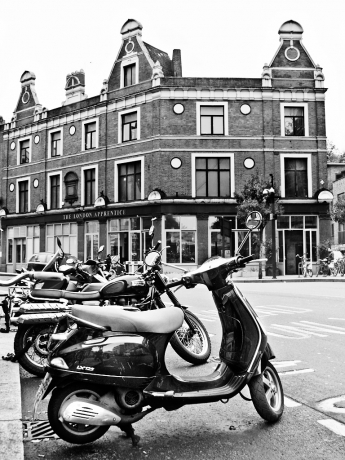It is very early on a Sunday morning in June and today promises to be every bit as scorching as yesterday. The street is deserted. Your ears ring, your eyes sting, your mouth tastes like a small bat has curled up and died in it. You’re wearing black leather, PVC, crushed velvet and heavy, oily make-up. You’re going home.
During this languorous, record-breakingly sultry summer of 1990 – when air conditioning is just a transatlantic rumour and the mercury keeps hitting 30 degrees – it has felt like the heat alone should be enough to kill Goth off. But, however embattled by an endless tide of acid house, rap and baggy psychedelia the scene may be, two bastions of Gothic London endure: twin all-night clubs at either end of the City Road. At the Angel is Slimelight, perched up high in a greasy-looking warehouse on Torrens Street. And, down in deepest, darkest Shoreditch, there is Wraith.
Wraith encapsulates the London Goth scene more intensely and more perfectly than its rival – flies a flag, if you will, in a much deeper shade of black. Regular incursions by HM Constabulary will force the club to skip along a series of endlessly changing venues, but for now it occupies the basement of Victorian boozer and long-time gay bar the London Apprentice, across the street from where the word “Progress” still beams off the walls of the 19th-century town hall. Wraith acts as an odd sort of antidote to this spirit of resolute Victorian optimism, catering to a clientele who are committed to looking on the gloomy side of life.
The regular hiss of dry ice means Wraith is frequently completely obscured by disco-smog. Indeed, the exact dimensions of the building will only become clear when the dawn begins cracking through the blacked-out windows. There is an improvised bar selling unrefrigerated Coke and Holsten Pils that grows warmer as the night goes on. Upstairs, a TV plays an endless loop of the Sisters of Mercy at the Royal Albert Hall in 1985. Army netting is draped around to provide further “atmosphere”, and the occasional soft furnishings contain bodies curled in pseudo-coital engagement.
Personal eccentricity is not so much encouraged as the price demanded for admission. There is the Glaswegian speed-freak who lives in a squat and sleeps only twice a week. The man we’ve nicknamed The Count is convinced he is a Romanian Gypsy prince and dresses in a cape with blood stains painted in lipstick around his mouth. A tiny, doll-like girl wears only black PVC and approximately her own body weight in bright blue hair extensions. The black guy who dances all night clad in nothing but black leather briefs, with a bottle of tequila in his hand, has, we know, a day job in advertising.
Others, less ruthless in their devotion to the cult of the individual, are content to model every last aspect of their hair, clothes and make-up on Robert Smith or Siouxsie Sioux circa 1983. And then there are the ex-Goths, almost a subculture in their own right, who are no longer interested in wearing black lipstick and pointy boots, but can’t quite think what else to do on a Saturday night, and turn up anyway, with their suedehead hair and KMFDM T-shirts.
Wraith is also the smell of amyl nitrate and hairspray. The taste of warm Thunderbird and Special Brew. The floor sticking to the soles of your shoes, the Hiroshima of the toilets, the relentlessly obnoxious bouncers. The driving rhythms of Joy Division’s Transmission and Rain by The Cult. And Depeche Mode’s Enjoy the Silence will always be associated in your mind with the mild tinnitus and insuperable fatigue that sets in at around 5 a.m. on a Sunday morning.
![]()
The Apprentice still stands on an unrecognisably chichi Old Street, but Wraith is long gone. London in those days was different. Less sleek, less cosmopolitan, less user-friendly. The streets were darker, grimier. At Wraith there was a kind of generalised bloody-mindedness which hung in the air, along with the smoke from our endless, endless cigarettes. Against all the smart money, though, the subculture to which Wraith gave succour has not only survived, but thrived. Take a gander at Camden Town and it’s plain to see that things go on much the same as they ever did. The Goths, like the Bourbons, have learned nothing and forgotten nothing. But, then again, progress is not really a Gothic concept.


